|
Gamma-Ray Bursts - by Ricky Leon Murphy:
Back to Cosmology
Introduction
In The Beginning
The Model of Gamma-Ray Bursts So
Far
A New Development
Gamma-Ray Burst Missions
Gamma-Ray Bursts of Special Note
GRB970228, GRB970508, GRB971223
GRB980425
GRB990123
GRB010222
GRB030329
GRB050709
A Table to Compare - Summary of Special Case GRB's
A Model for Gamma-Ray Bursts
Short GRB's
Long GRB's
An Aside - The Effects of a GRB on Earth
Conclusion
References
Image Credits
Gamma-Ray Bursts – Putting It All Together
Introduction:
Gamma-Ray Bursts – also known as
GRB’s – are one of Astronomy’s current hot topics. The evolution in
understanding these enigmatic events has proceeded very rapidly from the early
discoveries during the cold war to the current hypernova models and stellar
remnant merging models of today. This project will go through the early stages
of discovery including highlighting the space missions responsible or detecting
these events. Also covered will be some handpicked GRB events to compare them
with the current models.
Back to Top
In The Beginning:
Gamma-rays
themselves are not a mystery. In 1952, gamma-rays emanating from astronomical
phenomenon were thought to emanate from interactions between cosmic rays and
interstellar hydrogen (Prantzos, 2005). Gamma-ray emissions were even detected
from the Crab Nebula in 1961 by the United States satellite, OSO-3. However,
these were relatively lower energy – in the range of 100 to 300 keV. Another US
satellite, the OSO-7, detected gamma-rays from a solar flare in 1972. It wasn’t
until 1973 that gamma-ray astronomy became a serious topic. During this time,
the Cold War between the United States and Soviet Union was in full swing, and
to “determine” if the Soviets were complying with the nuclear test ban treaty,
the VELA series spacecraft was launched to detect higher energy gamma-rays –
higher than those detected coming from the Sun or the Crab Nebula. While no
atmospheric gamma-rays were detected, gamma-ray bursts lasting an average of 10
ms to 10 s were detected in random directions on the sky rather than from the
Earth, with no detection occurring in the same place twice (Hurley, 2005).
In order to solve this mystery,
the COS-B satellite was sent in 1975 to study these high energy sources of gamma
radiation in detail.

Figure 1
The above image (from the
ESA Website) demonstrates the existence of bright gamma-ray sources within
our galaxy. It was determined at this time (between 1975 and 1982 when the COS-B
mission was active) that the gamma-ray sources
were restricted to our own galaxy.
Back to Top
The Model of Gamma-Ray Bursts So
Far:
Because these gamma-ray emissions
were detected, the source of these emissions must be pretty strong – between 1038
to 1042 ergs.
There was no known phenomenon to conform to this energy requirement except for
neutron stars. While neutron stars themselves do not emit this much energy,
their magnetic fields could provide the catalyst required to accelerate
electrons fast enough and hot enough to account for this energy. Additionally,
material accreted onto the neutron star – like a comet, asteroid or some other
piece of debris – could be heated to the point that such energy could be
generated.
This model seemed to have been
confirmed by the US satellite HEAO-3 when spectroscopy of a gamma-ray pulsar was
shown to contain a high energy spectral line of Aluminum (Prantzos, 2005). The
aluminum spectral line was thought to be from supernova. A supernova within our
galaxy seems to fit with the apparent brightness detected since at least a 3
solar mass star is required to provide the nucleosynthesis to create aluminum
(Charles and Seward, 1995). The stellar remnant for such a star is a neutron
star.
Back to Top
A New Development:
In 1991, the Compton Gamma-Ray
Observatory was sent to explore a wide range of high energy astrophysics from 30
keV to 30 GeV. While this observatory carried four experiments, the most
remarkable was the Burst And Transient Source Experiment – or BASTE.

Figure 2
What was discovered was that GRB’s
were not limited to our galaxy. Instead a homogenous distribution of GRB’s
existed in every region of sky. The image above shows 2,704 GRB’s detected by
the BASTE experiment. Basically what this means is that the majority of
detections by BASTE were outside the plane of our galaxy. It was only the
resolution of these new instruments that allowed rapid follow-up of GRB events
to determine there locations.
Another remarkable observatory -
launched in the year 1994, the BeppoSAX satellite managed to capture the
transient events of GRB’s – sometimes within hours of detection. While the
actual GRB event was not captured, the residual hot X-Ray afterglow was
detected.
|

Figure 3 |
This image is one such afterglow in the X-Ray wave
band. This afterglow can last up to a few weeks (Hurley, 2005).
While BeppoSAX was able to actually pinpoint the
GRB source, it was not able to catch a GRB in the act. |
The previous model of GRB’s being
the result of neutron stars and their magnetic fields may no longer be valid.
GRB’s are bright and if they occur well outside our galaxy, they must fit a new
energy requirement. The magic number:
1052 ergs or greater.
There are not many sources capable
of producing this much energy, and this new requirement has placed the GRB as
the brightest, most violent object in the Universe. In most cases, a GRB will be
brighter than the combined light output of its host galaxy (Freedman and
Kaufman, 2005).
The ten images below models what a
GRB might look like, and how long they last (http://imagers.gsfc.nasa.gov/ems/gamma.html):
|
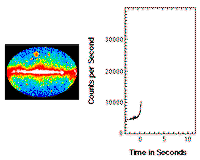
Frame 1 -
Figure 4 |
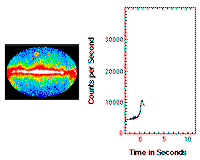
Frame 2 -
Figure 5 |
|

Frame 3 -
Figure 6 |

Frame 4 -
Figure 7 |
|
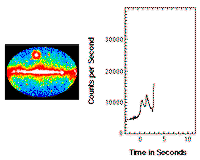
Frame 5 -
Figure 8 |
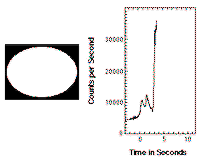
Frame 6 -
Figure 9 |
|

Frame 7 -
Figure 10 |
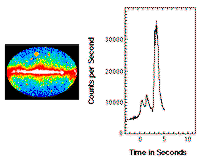
Frame 8 –
Figure 11 |
|

Frame 9 -
Figure 12 |
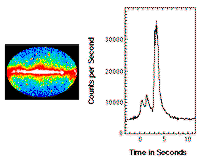
Frame 10 -
Figure 13 |
The graph next to each of the
images shows the average photon counts – including the galaxy image which is in
the center of the image – the GRB occurs near the top. Notice the counts of
frame 6, as well as the overall duration. This burst lasted only about a second.
The relative short-lived event like this makes them very hard to directly detect
them as they burst. Our only hope is to piece together a series of satellites to
form a network to detect GRB’s, and to quickly slew a telescope
to the source with the hopes of looking for either the residual X-ray emission
or find an optical counterpart. The network that exists now is called the
Third Interplanetary Network. It is the goal of this network to detect a GRB
event within 10 seconds – or less.
Back to Top
Gamma-Ray Burst Missions:
It is probably important to
mention that to detect GRB’s we need to be above the Earth’s atmosphere – or at
least 100 kilometers above the surface (http://imagers.gsfc.nasa.gov/ems/gamma.html):
Our atmosphere naturally blocks many of the harmful rays –
including gamma-rays - so we must detect and observe these events far above the
surface.
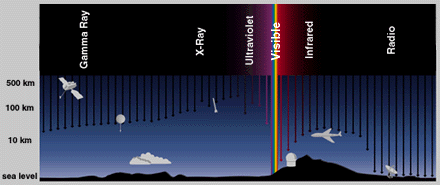
(Figure
14)
There are, and have been, a number
of observatories and satellites used in search of GRB’s. The list below shows
all of the observatories that have either solely or partly contributed to the
collection of data and the detection of GRB’s. The missions of significant
contributions are in bold.
|
Mission: |
Date of
Operation: |
Contribution: |
|
OSO-3 – Orbiting Solar Observatory |
March 8, 1967 to
April 4, 1982 |
Detected gamma-rays
from the Crab nebula. |
|
OSO-7 – Orbiting Solar Observatory |
September 29, 1971
to July 9, 1974 |
Detected higher
energy gamma-rays from the Sun. |
|
VELA |
July 1969 to
April 1979 |
A series of four
satellites designed to detect atmospheric gamma-rays: VELA 5A, 5B, 6A
and 6B. Detected a total of 73 gamma-ray bursts – but not in our
atmosphere. |
|
COS-B |
August 9, 1975 to
April 25, 1982 |
Provided the
first map of galactic gamma-ray burst sources. |
|
HEAO-3 |
September 20, 1979
to May 29, 1981 |
Confirmed the
spectra of a gamma-ray source – a pulsar. |
|
GRANAT |
December 1, 1989 to
November 27, 1998 |
A Russian X-Ray and
Gamma-Ray observatory. GRB entries into the PHEBUS Gamma-Ray Burst
Catalog |
|
ROSAT |
June 1, 1990 to
February 12, 1999 |
Detected numerous
GRB’s during its all-sky X-Ray map. |
|
Ulysses |
October 6, 1990 to
present |
Primarily a solar
observatory, it does contain a GRB detection device and is a member of
the Third Interplanetary Network. |
|
Compton Gamma-Ray Observatory |
April 5, 1991 to
June 4, 2000 |
A series of four
experiments, most noted of which is BASTE – which confirmed GRB’s are
not restricted to our galaxy. |
|
Yohkoh |
August 30, 1991 to
present |
A Japanese X-Ray and
Gamma-Ray Observatory. A member of the Third Interplanetary Network to
detect GRB’s. |
|
SROSS – Strechted Rohini Satellite Series |
May 4, 1994 to July
12, 2001 |
Discovered 12
candidate sources for Gamma-Ray Bursts and was a member of the Third
Interplanetary Network to detect GRB’s |
|
Wind |
November 1, 1994 to
present |
Primarily an
energetic particle and magnetic field observatory, it does contain a
TGRS – Transient Gamma-Ray Spectrometer. |
|
BeppoSAX |
April 30, 1996
to May 2, 2002 |
Pinpointed GRB
source and detected X-Ray afterglow |
|
HETE |
November 4, 1996 to
April 6, 2002 |
Continual mapping of
GRB sources. |
|
Chandra X-Ray Observatory |
July 23, 1999 to
present |
Monitors X-Ray
afterglows |
|
XMM-Newton |
December 10, 1999 to
present |
Monitors X-Ray
afterglows |
|
HETE2 |
October 9, 2000
to present |
GRB detection and
spectroscopy – follow-up X-Ray afterglow studies. |
|
HESSI – High Energy Solar Spectroscopic Imager |
February 5, 2002 to
present |
A member of the
Third Interplanetary Network to detect GRB’s. |
|
INTEGRAL |
October 17, 2002 to
present |
A GRB telescope, but
also focuses on a wide variety of galaxy observation as well. |
|
SWIFT |
November 20, 2004
to present |
A GRB telescope
that is alo capable of X-Ray, UV and Optical Observation |
|
DMSP – Defense Meteorological Satellite Program |
Current |
A series of weather
satellites that are part of the Third Interplanetary Network to detect
Gamma-Ray Bursts. |
Back to Top
Gamma-Ray Bursts of Special Note:
This section will cover a few of
the GRB’s that have helped mold our current models – which will be covered
later.
But first, what is in a name? The
naming convention for Gamma-Ray Bursters are GRB followed by the date – two
digit year, two digit month and two digit day. This is named after the date of
initial discovery. This is also called the “BASTE term.”
Back to Top
GRB’s 970228, 970508, and 971223
(Wijers and Galama, 1999)(Galama
et al., 2000):
|
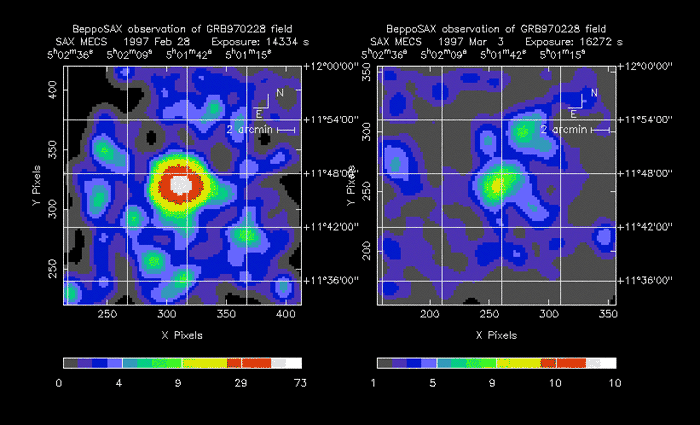
Figure 15: The BeppoSAX X-Ray afterglow image of GRB 970228. |
GRB 970228 is unique in that it is
the first GRB to have an optical counterpart. The majority of detections by
BASTE and BeppoSAX were of X-Ray afterglows. These three GRB’s were considered
long and radiated energy from the gamma-ray spectrum through to radio spectrum.
According to Wijers and Galama (1999), the nature of the optical counterpart is
due to synchrotron emissions resulting from the reduced speed of the ejecta
(thought to be a supernova). Reexaminations of the power curves of these GRB’s
resulted in a similar appearance to a Type 1c supernova power curve.
|

Figure 16: The light curve decay of GRB 970228. |
Back to Top
GRB 980425
(Waxman, 2004)(Guetta et al.,
2004):
This unusual GRB is one of the
closest GRB events ever recorded – only 100 million light-years away. While the
brightness was that of a cosmological GRB, the close proximity of this event was
probably the result of the relativistic jets being viewed off-axis.
Interestingly, this event also carries the designation SN1998bw – meaning that
this was also recorded as a supernova. This particular supernova has become a
member of a handful of GRB’s that occur near to us – at:
 . .
Figure 17 is an optical image of
SN1998bw/GRB 980425. At first glance, this event looks just like any other
supernova. Only by comparing the light-curve distribution from BeppoSAX and
BASTE to other known GRB’s was the determination that this event is a GRB.
|

Figure 17: GRB 980425 – the optical counterpart to the nearby
GRB at 100 million light years. |
Back to Top
GRB 990123
(Briggs at al., 1999)(Dai and
Lu, 1999):
This particular GRB is special in
that it was the first GRB to be simultaneously detected in the gamma-ray, x-ray,
radio and optical spectrums. It is thought the result of this is due to us
looking directly into the beam of the source object (star).
Figure 18 shows what appears to be
residual material left over from the shock waves of non-thermal, relativistic
electrons – results from the internal shock waves as a by product of collisions
of material at different velocities.
|

Figure 18: Hubble Space telescope image of GRB 990123 – notice
the jet of relativistic material left over from the event. |
This residual material is actually
the surrounding medium that got in the way.
The BeppoSAX X-ray image (figure
19) of this event shows a curious, near perfect circular object which seems
to support the thought of this even beaming directly towards our planet. The
energy output of this event is estimated to be:
 . .
This particular GRB is at the
“usual” cosmological distances – greater than a redshift of 1.6.
|
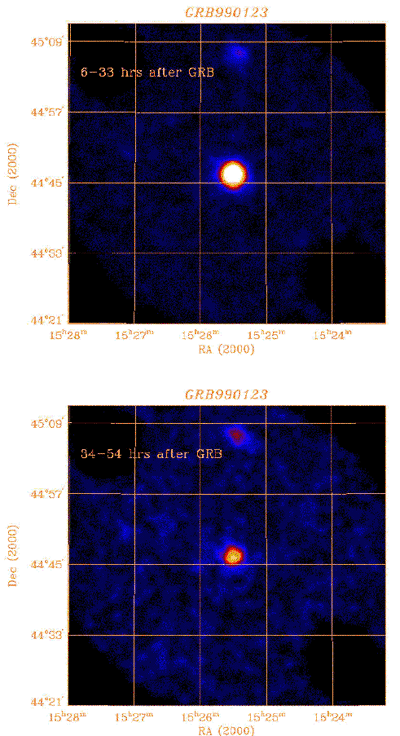 |
Figure 19:
This BeppoSAX image shows
a near circular appearance of this GRB event.
Also notice how quickly
the X-ray signature fades quickly – losing half its brightness in under
54 hours after the event.
This GRB was
simultaneously detected in the gamma-ray, x-ray, radio and optical
spectrum. It is also one of the brightest GRB’s recorded to date (1999). |
Figure 20 demonstrates the
double-spectrum of an energetic GRB, thought to be both the relativistic and
non-relativistic shockwaves emanating from the source. This will become the
typical spectral appearance of a GRB.
|
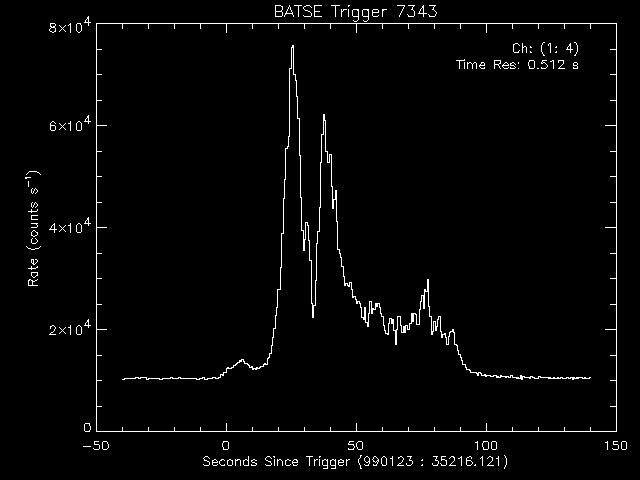
Figure 20: The double-peaked power spectrum of a GRB. |
Back to Top
GRB 010222
(Krzysztof et al., 2001)(Frail
et al., 2002)(Galama et al., 2003)(Bjornsson et al., 2002):
This particular GRB is also a
distant event at a redshift of z = 1.5. What makes this particular event special
is that its host galaxy is a starburst galaxy – that is a galaxy that is
actively forming high mass stars.
|
 |
Figure 21 (left) is a rather boring image of the optical counterpart
to GRB 010222. The spectrum of this event, as well as its host galaxy,
has strong metallic lines. Continual study of the spectrum of this event
suggests the beams of a GRB are more narrow than expected. |
In addition, this particular event
was also a very bright one; however, the decay rate has been one of the slowest
ever measured – taking almost twice as long for the decay as compared to
figure 16.
Measurements of the electron
distribution of this event support the jet model of a GRB – discussed later.
Back to Top
GRB 030329
(Guetta et al., 2004(Vanderspek
et al., 2004):
This unusual event occurred at z =
0.17, that is only 2 billion light years distant. In addition, the light curves
and spectra of this event are very similar to SN1998bw.
|
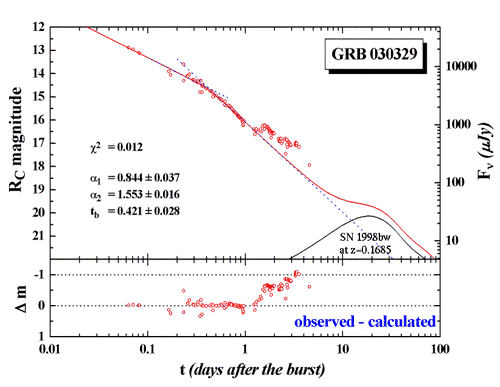 |
Figure 23: Decay rate of GRB 030329. Notice the curve of
SN1998dw on the lower right which corresponds well to the GRB event. |
Figure 23 shows an example of the
light curve of this event as compared to the optical light curve of SN1998bw.
|
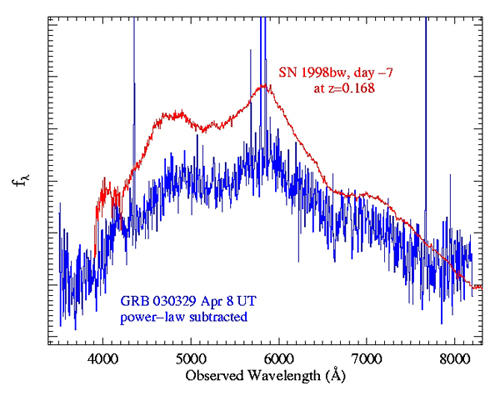 |
Figure 24:
The power curves of both
GRB 030329 and SN1998bw indicate a near identical appearance. |
The matching of the supernova
spectrum with the GRB spectrum is important in determining the source of GRB’s.
Back to Top
GRB 050709 (http://www.eso.org/outreach/press-rel/pr-2005/pr-26-05-p2.html)
The HETE-2 satellite detected a 70
millisecond GRB 2,400 million light years away in a young, star-forming dwarf
galaxy.
|
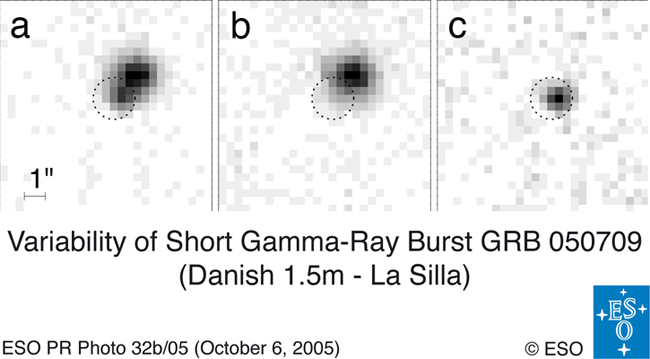
Figure 25: GRB 050709 within a young, star-forming dwarf galaxy. |
By observing the light curve for
20 days, it was determined that this (and other) short GRB events cannot be
explained by the hypernova model. Instead, this GRB was probably the result of
merging neutron stars.
|
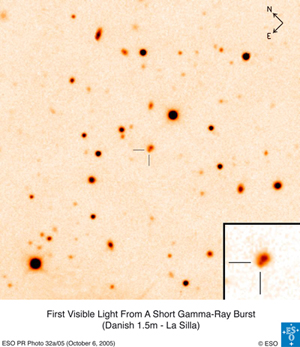 |
Figure 26:
Visible light image of GRB
050709. The light curve was observed for 20 days. This was done to
determine if any significant decay line would be visible. Short GRB’s
like this one lack the slow decay of long GRB’s. It is inferred that the
model that describes long and short GRB’s are different. |
Back to Top
A Table to Compare – Summary of Special Case
GRB’s:
|
GRB Event: |
Comments: |
|
GRB 970228 |
First GRB with optical counter-part; spectrum
similar to Type 1c Supernova |
|
GRB 970508 |
Second GRB with optical counter-part; spectrum
similar to Type 1c Supernova |
|
GRB 971223 |
Third GRB with optical counter-part; spectrum
similar to Type 1c Supernova |
|
GRB 980425 |
Nearby GRB, also an optical supernova SN1998bw |
|
GRB 990123 |
Bright, energetic GRB – looking into the beam (jet) |
|
GRB 010222 |
Long decay supporting jet emission of a GRB |
|
GRB 030329 |
Matching spectra between GRB and supernova; GRB
related to supernovae |
|
GRB 050709 |
Short GRB, probably merging neutron stars |
These particular GRB events have
provided valuable insight to determine the source of these events. In
particular:
-
There are a few cases where
a GRB is relatively close to us although the vast majority are at
“cosmological” distances
-
There is an optical
counterpart of a GRB which supports a relation to supernova
-
Matching spectra between
GRB’s and supernova also support the relation between GRB’s and supernova
-
Short and Long GRB events
(see below) have different mechanisms – short GRB’s equal neutron star
merging while long GRB’s are probably intense supernova called “hypernova”
The next section will cover the
current models of GRB’s.
Back to Top
A Model for Gamma-Ray Bursts:
GRB’s are the Universe’s most
violent event. Luckily, the vast majority of these events are at cosmological
distances, with the most distant GRB detected at a z = 6.3 – that means the
event occurred when the Universe was “only” 900 million years old. There is no
apparent reason for this other than statistical data of the collected GRB
detections – although a very novel idea is inferred by the rate of GRB’s at a
high redshift. The introduction of metal into the spectrum of GRB’s in the early
universe is though to be the result of massive Population III stars (Murakami et
al., 2005). This supports the double-ionizations as detected by the Wilkinson
Microwave Anisotropy Probe (WMAP).
There are currently two types of
GRB’s:
-
Short Gamma-Ray Bursts
-
Long Gamma-Ray Bursts
Both of these events have a
different mechanism.
Back to Top
Short Gamma-Ray Bursts:
A short GRB is any event that
lasts less than 2 seconds. GRB 050709 and data from the HETE-2 observatory has
really provided the breakthrough of determining the source of a short gamma-ray
burst. These short events are very powerful, but rare to catch – that is until
HETE-2. What makes the short GRB so special is that there are not jets of
relativistic energy fueling the event. That is where a massive star would have a
variety of layers to provide the energy; a short GRB is missing this. Therefore,
the current model of a short GRB is a merging of two neutron stars (http://www.eso.org/outreach/press-rel/pr-2005/pr-26-05.html).
|

Figure 27: The merging neutron star scenario. |
What supports the short GRB model
most of all is the lack of a significant optical afterglow that would have
resulted from a supernova. Such afterglows are present in long GRB events.
Back to Top
Long Gamma-Ray Bursts:
Over 2/3’s of all GRB events are
long GRB’s (Gou et al., 2004). These events last longer than 2 seconds. As a
result, most of our data in determining the nature of GRB’s is based on long GRB
events. The model for long GRB’s is a hypernova resulting from a star with a
solar mass of 30. An optical counterpart to a long GRB and matching spectra to
supernova (see the
comparison table above) support the supernova model. Additionally, the SWIFT
gamma-ray satellite has detected near-infrared afterglows as well as Iron
spectral lines
from long GRB’s – data that also supports the hypernova model (Gou et al.,
2005)(Berger et al., 2005).
In this case, the SWIFT
observatory plays a key role in finding not only GRB events, but also searching
for the faint afterglows that would otherwise be hidden from Earth-based
telescopes.
|
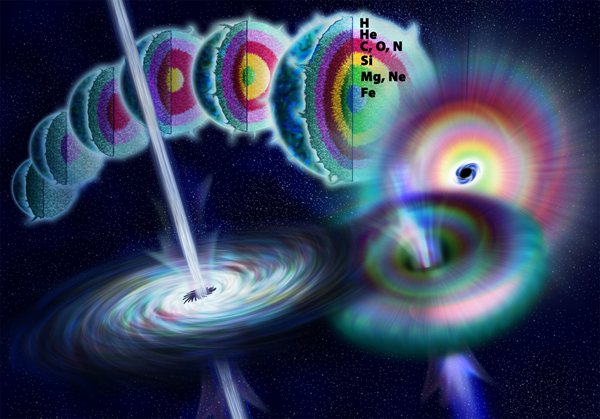
Figure 28: The history of a massive star to a black hole
emanating gamma-rays. |
Figure 28 (above) sums up the
hypernova model quite nicely. The formation of a black hole
is inferred from a very high mass star that also emanates a burst of gamma-rays
(the GRB’s) in the form of two jets.
Figure 29 goes into detail the jet
model of a GRB. Make a note of the gamma symbol in the yellow, the letter X in
the orange and the letter V outside the jet. These correspond to the frequency
of the jet at the given location. The gamma-ray emission is the result of the
initial supernova explosion – evident of the iron lines in the spectra.
Additionally, there are presumed to be several concentric shells of material
moving at a variety of speeds. These speeds indicate the energy that is emitted.
The slower the expanding shell, the more energy is built up hence the long
afterglow into the radio spectrum.
Data from the XMM-Newton X-Ray
observatory and supercomputer simulations have “solved” the GRB mystery (http://www.pparc.ac.uk/nw/press/gamma.asp).
Supporting the data from SWIFT and the HETE-2, a long GRB is the result of a
collapsar, or hypernova – a supernova of a high mass star that forms a black
hole.
|
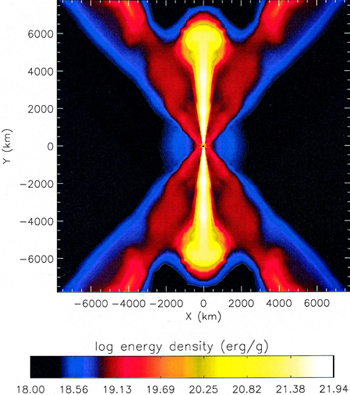 |
Figure 30:
A side view of a computer
simulated GRB shows the most intense energy (yellow) being collimated
along the direct line of sight of the relativistic jets from this
hypernova model.
The other colors are
analogous to the energy spectrum – red for X-Ray and blue for radio.
|
Back to Top
An Aside
– The Effects of a GRB on Earth:
An interesting article appeared in
the November 2005 issue of Astronomy Magazine. The article discusses the
possibility of life in our galaxy and includes a section on the effects of a
nearby GRB to life on Earth.
This particular scenario places a
long GRB (lasting 10 seconds) event at only 6500 light years from Earth (Nadis,
2005). The result is a destruction of our Ozone and a smog that envelopes the
planet for several years. The UV-B radiation from the Sun is no longer blocked
which results in damage to DNA. The steps involved (Nadis, 2005):
-
Within a few weeks, Nitrous
Oxide and Nitrous Dioxide (NO and NO2) are produced by the GRB – these
compounds destroy the Ozone layer
-
UV-B radiation increases by
50% destroying DNA
-
After a few months, the NO
and NO2 cover the entire planet in a brown smog – the Ozone begins to
regenerate but only at a 20% level
-
After 10 years, the NO and
NO2 sink to a level where they are rained out as acid rain
-
In 15 years, the atmosphere
returns to normal, but the Earth has now entered a global cooling trend as a
result of the smog. Most of the land and marine life are killed over the
course of these 15 years after the GRB event
|
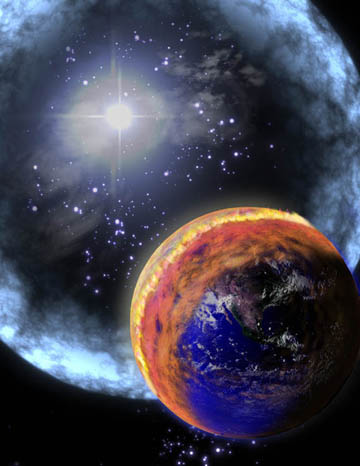 |
Figure 31:
A nearby GRB would destroy
our Ozone layer and create a smog of Nitrous Oxide. DNA is destroyed by
the UV-B rays from the Sun. It can take several months for the Ozone to
regenerate, but at a paltry 20%. Several years later, the nitrous oxide
is rained out as acid rain. A few years after, the atmosphere returns to
normal, but the Earth is now in a global cooling trend (Image
Credit). |
A GRB is a violent event, and is
also deadly to life on Earth if a GRB were to occur near us. There is
speculation that such an event may have contributed to the dinosaur extinction,
but there is little data to support this.
Back to Top
Conclusion:
Much progress has been made in
determining the true nature of a Gamma-Ray Burst. Continual observations by the
SWIFT and HETE-2 space-based observatories with follow up observation using
radio and optical telescopes have provided valuable data to mold the models that
explain this phenomenon. As it stands, there are two types of Gamma-Ray Busts
with two different models:
-
Short Gamma-Ray Bursts – GRB
events lasting 2 seconds of less, the result of which is the merging of
compact objects like neutron stars
-
Long Gamma-Ray Busts –
events lasting longer than 2 seconds that are the result of a collapsar or
hypernova, a type of supernova of a very high mass star.
While Gamma-Ray Bursts are
primarily a cosmological event, there are a handful of events that have occurred
closer to Earth. It is inferred that such an event probably assisted in the
extinction of life on Earth millions of year ago.
The models that describe the
Gamma-Ray Burst are in their infant stages, but this is a perfect example of
observational data supporting computer and mathematical models. Additionally,
further study using tools like SWIFT and HETE-2 will provide the continuum of
data required to solidify these models.
Back to Top
References:
Berger, E. et al. “The Discovery of the Optical and Near-IR
Afterglows of the First SWIFT Gamma-Ray Bursts.” The Astrophysical Journal,
629:328-333, August 10, 2005.
Bjornsson, G.; Hjorth, J.; Pedersen, K. and J.U. Fynbo.
“The Afterglow of GRB 010222: A Case of Continuous Energy Injection.” The
Astrophysical Journal, 579:L59-L62, November 10, 2002.
Briggs, M.S. et al. “Observations of GRB 990123 by the
Compton Gamma Ray Observatory.” The Astrophysical Journal, 524:82 – 91, October
10, 1999.
Chandra X-Ray Observatory. “X-Ray Astronomy Field Guide.”
Internet
Charles, Philip and Frederick Seward. Exploring the
X-Ray Universe. Cambridge University Press, 1995.
Dai, Z.G. and T. Lu. “The Afterglow of GRB 990123 and a
Dense Medium.” The Astrophysical Journal, 519:L155-L158, July 10, 1999.
Frail, D.A. et al. “GRB 012222: A Burst Within a
Starburst.” The Astrophysical Journal, 565:829-835, February 1, 2002.
Freedman, Rodger and William Kaufmann II. Universe.
Seventh Edition.” W.H. Freeman and Company. New York, 2005.
Galama, T.J. et al. “Evidence for a Supernova in Reanalyzed
Optical and Near-Infrared Images of GRB 970228.” The Astrophysical Journal,
536:185-194, June 10, 2000.
Galama, T.J. et al. “Hubble Space Telescope and
Ground-Based Optical and Ultraviolet Observations of GRB 010222.” The
Astrophysical Journal, 587:135-142, April 10, 2003.
Guetta, Dafne; Perna, Rosalba; Stella, Luigi and Mario
Vietri. “Are All Gamma-Ray Bursts Like GRB 980425, GRB 030329, and GRB 031203?”
The Astrophysical Journal, 615:L73-L76, November 10, 2004.
Hendon, Arne. “Observing Gamma-Ray Bursters by Amateurs.”
Encyclopedia of Astronomy & Astrophysics, 2005.
Hurley, Kevin. “Gamma-Ray Bursts.” Encyclopedia of
Astronomy & Astrophysics, 2005.
Gehrels, N. et al. “The SWIFT Gamma-Ray Burst Mission.” The
Astrophysical Journal, 611:1005-1020, August 2004.
Gou, L.J.; Meszaros, P.; Abel, T. and B. Zhang.
“Detectability of Long-Gamma-Ray Burst Afterglows from Very High Redshifts. “
The Astrophysical Journal, 604:508-520, April 1, 2004.
Gou, L.J., Meszaros, P. and T.R. Kallman. “Detectability of
Gamma-Ray Burst Iron Lines by SWIFT, CHANDRA, and XMM-Newton.” The Astrophysical
Journal, 624:889-897, May 2005.
Guetta, Dafne; Rosalba, Perna; Stella, Luigi and Mario
Vietri. “Are All Gamma-Ray Bursts Like GRB 980425, GRB 030329, and GRB 031203?”
The Astrophysical Journal, 615:L73-L76, November 10, 2004.
Jakobsson et al. “SWIFT Identification of Dark Gamma-Ray
Bursts.” The Astrophysical Journal, 617:L21-L24, December 2004.
Krzysztof, Z. et al. “Rapid UBVRI Follow-Up of the Highly
Collimated Optical Afterglow of GRB 010222.” The Astrophysical Journal,
563:592-596, December 20, 2001.
Meszaros, R. “Theories of Gamma-Ray Bursts.” Annual Review
of Astronomy and Astrophysics – Pre-Print, 2001.
Mukherjee, Soma et al. “Three Types of Gamma-Ray Bursts.”
The Astrophysical Journal, 508:314-327, November 1998.
Murakami, T.; Yonetoku, D.; Umemura, M.; Matsubayashi, T.
and R. Yamakazi. “The Reionization History and Earlt Metal Enrichment Inferred
from the Gamma-Ray Burst Rate.” The Astrophysical Journal, 625:L13-L16, May 30,
2005.
Nadis, Steve. “Do We Live in a Cosmic Shooting Gallery?”
Astronomy Magazine, November 2005, pages 34 to 41.
Prantzos, Nikos. “Gamma-Ray Astronomy.” Encyclopedia of
Astronomy & Astrophysics, 2005.
Vanderspek, R. et al. “HETE Observations of the Gamma-Ray
Burst GRB 030329: Evidence for an Underlying Soft X-Ray Component.” The
Astrophysical Journal, 617:1251-1257, December 20, 2004.
Waxman, Eli. “The Nature of GRB 980425 and the Search for
Off-Axis Gamma-Ray Burst Signatures in Nearby Type 1b/c Supernova Emission.” The
Astrophysical Journal, 602:886-891, February 20, 2004.
Weeks, Trevor. “Gamma-Ray Telescopes.” Encyclopedia of
Astronomy & Astrophysics, 2005.
Wijers, R.A.M.J. and T.J. Galama. “Physical Parameters of
GRB 970508 and GRB 971214 from their Afterglow Synchrotron Radiation.” The
Astrophysical Journal, 523:177-186, September 20, 1999.
Back to Top
Image
Credits:
Figure 1:
http://www.rssd.esa.int/index.php?project=COSB&page=index
Figure 2:
http://cossc.gsfc.nasa.gov/docs/cgro/batse/
Figure 3:
http://bepposax.gsfc.nasa.gov/bepposax/first/grb970228.html
Figure 4:
http://imagers.gsfc.nasa.gov/ems/gamma.html
Figure 5:
http://imagers.gsfc.nasa.gov/ems/gamma.html
Figure 6:
http://imagers.gsfc.nasa.gov/ems/gamma.html
Figure 7:
http://imagers.gsfc.nasa.gov/ems/gamma.html
Figure 8:
http://imagers.gsfc.nasa.gov/ems/gamma.html
Figure 9:
http://imagers.gsfc.nasa.gov/ems/gamma.html
Figure 10:
http://imagers.gsfc.nasa.gov/ems/gamma.html
Figure 11:
http://imagers.gsfc.nasa.gov/ems/gamma.html
Figure 12:
http://imagers.gsfc.nasa.gov/ems/gamma.html
Figure 13:
http://imagers.gsfc.nasa.gov/ems/gamma.html
Figure 14:
http://imagers.gsfc.nasa.gov/ems/gamma.html
Figure 15:
http://www.mpe.mpg.de/~jcg/grb970228.html
Figure 16:
http://www.mpe.mpg.de/~jcg/grb970228.html
Figure 17:
http://www.mpe.mpg.de/~jcg/grb980425.html
Figure 18:
http://www.mpe.mpg.de/~jcg/grb990123.html
Figure 19:
http://www.mpe.mpg.de/~jcg/grb990123.html
Figure 20:
http://www.mpe.mpg.de/~jcg/grb990123.html
Figure 21:
http://www.mpe.mpg.de/~jcg/grb010222.html
Figure 22:
http://www.mpe.mpg.de/~jcg/grb010222.html
Figure 23:
http://www.mpe.mpg.de/~jcg/grb030329.html
Figure 24:
http://www.mpe.mpg.de/~jcg/grb030329.html
Figure 25:
http://www.eso.org/outreach/press-rel/pr-2005/pr-26-05-p2.html
Figure 26:
http://www.eso.org/outreach/press-rel/pr-2005/pr-26-05-p2.html
Figure 27:
http://www.eso.org/outreach/press-rel/pr-2005/pr-26-05-p2.html
Figure 28:
http://www.nasa.gov/images/content/133208main_gamma_h_star_history_final.jpg
Figure 29:
http://www.oamp.fr/ECLAIRS/01home/home.htm
Figure 30:
http://www.pparc.ac.uk/nw/press/gamma.asp
Figure 31:
http://www.nasa.gov/vision/universe/starsgalaxies/gammaray_extinction.html
Back to Top |

